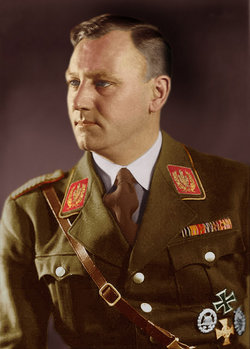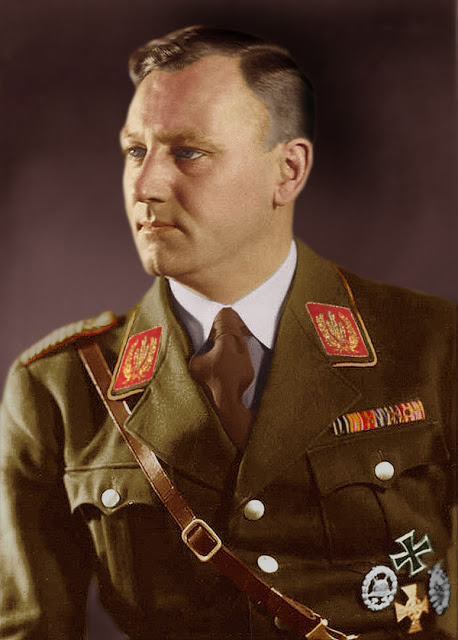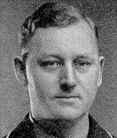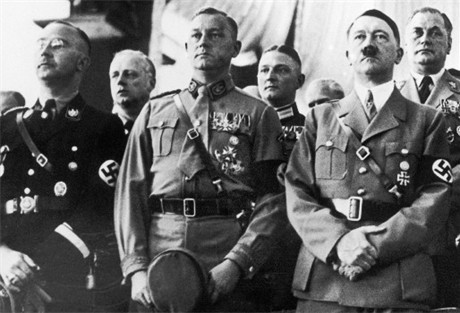Lutze joined the National Socialist German Workers Party (NSDAP or Nazi Party) in 1922, and the Prussian State Council. He became an associate of Franz Pfeffer von Salomon, the first leader of the SA. Together, they determined the structure of the organization.
He also worked with Albert Leo Schlageter in the resistance/sabotage of the Belgian and French occupation of the Ruhr in 1923. His organization of the Ruhr for the SA became a model for other regions after 1926. In October 1931, he organized a huge joint rally in Braunschweig (Brunswick) of SA and SS men to show both strength in strife-weary Germany and loyalty to their leader, Adolf Hitler. This was before Hitler came to national power as Chancellor of Germany. Over 100,000 men attended the rally hosted by SA-Gruppe Nord under the leadership of Lutze. At the rally, the SA assured Hitler of their loyalty and Hitler in turn increased the size of the SA with the creation of 24 new Standarten (regiment-sized formations). Hitler never forgot this show of loyalty by Lutze, and a badge was made to commemorate the event. Lutze rose through the ranks and by 1933 was a SA-Obergruppenführer. In March 1933, he was appointed police president of Hanover and later its provincial governor and state counselor.
Lutze's participation in the Night of the Long Knives in 1934 was very important, as it was he who informed Hitler about Ernst Röhm's anti-regime activities. In preparation for the purge, Heinrich Himmler and his deputy Reinhard Heydrich, chief of the SS Security Service (SD), assembled dossiers of manufactured evidence to suggest that Röhm was going to overthrow Hitler. Meanwhile Göring, Himmler, Heydrich and Lutze (at Hitler's direction) drew up lists of those who should be liquidated starting with seven top SA officials. At least 85 people died during the purge, although the final death toll may have been in the hundreds. After the purge Lutze succeeded Röhm as Stabschef SA, but the SA no longer had as prominent a role as it did in the early days of the party. One of Lutze's major tasks would be overseeing a large reduction in the SA, a task welcomed by the SS and the regular armed forces. On June 30, 1934 Hitler issued a twelve-point directive to Lutze to clean up the SA and wrote that "SA men should be leaders, not ludicrous apes".
At the Nazi Party Congress in Nuremberg in September 1934, William L. Shirer observed Hitler speaking to the SA for the first time since the purge, absolving the SA from crimes committed by Röhm. Shirer also noted Lutze speaking there and described him as possessing a shrill unpleasant voice, and thought the "SA boys received him coolly". In Leni Riefenstahl's Triumph of the Will however, Lutze is seen being mobbed by the SA as he departed at the end of his evening rally speech, his automobile barely making it through the crowd. He is also the only speaker other than Hitler who receives the dramatic low angle shots at the podium. Only Hitler, Himmler, and Lutze are shown in the march to the World War I cenotaph, where they laid a wreath. The makers of the film were giving the then little known Lutze some of the prestige of Hitler.
Lutze maintained his position in the weakened SA until his death. On May 1, 1943 near Potsdam, driving too fast in a curve caused an accident that badly injured Lutze as well as killing his oldest daughter Inge and greatly injuring his younger daughter. Viktor Lutze died during an operation in a hospital in Potsdam the next evening. News reports stated that the accident involved another vehicle, keeping the news of reckless driving from the public. This may have contributed to theories that Lutze has been killed as Röhm had been, or that partisans assassinated him. Hitler ordered Joseph Goebbels to convey his condolences to Viktor's wife and son. Goebbels, in his diaries, had already described Lutze as a man of "unlimited stupidity" but at his death decided he was a decent fellow.
The esteem in which Lutze was held is indicated by the fact that Hitler ordered a lavish state funeral for him in the Reich Chancellery. Hitler attended in person, something he rarely did at that stage in the war. Lutze was posthumously awarded the Highest Grade of the German Order by Hitler. Hitler also took this opportunity to order party, army, and government officials to curtail speeding, specifically requesting they drive no faster than 50 miles per hour.
Lutze joined the National Socialist German Workers Party (NSDAP or Nazi Party) in 1922, and the Prussian State Council. He became an associate of Franz Pfeffer von Salomon, the first leader of the SA. Together, they determined the structure of the organization.
He also worked with Albert Leo Schlageter in the resistance/sabotage of the Belgian and French occupation of the Ruhr in 1923. His organization of the Ruhr for the SA became a model for other regions after 1926. In October 1931, he organized a huge joint rally in Braunschweig (Brunswick) of SA and SS men to show both strength in strife-weary Germany and loyalty to their leader, Adolf Hitler. This was before Hitler came to national power as Chancellor of Germany. Over 100,000 men attended the rally hosted by SA-Gruppe Nord under the leadership of Lutze. At the rally, the SA assured Hitler of their loyalty and Hitler in turn increased the size of the SA with the creation of 24 new Standarten (regiment-sized formations). Hitler never forgot this show of loyalty by Lutze, and a badge was made to commemorate the event. Lutze rose through the ranks and by 1933 was a SA-Obergruppenführer. In March 1933, he was appointed police president of Hanover and later its provincial governor and state counselor.
Lutze's participation in the Night of the Long Knives in 1934 was very important, as it was he who informed Hitler about Ernst Röhm's anti-regime activities. In preparation for the purge, Heinrich Himmler and his deputy Reinhard Heydrich, chief of the SS Security Service (SD), assembled dossiers of manufactured evidence to suggest that Röhm was going to overthrow Hitler. Meanwhile Göring, Himmler, Heydrich and Lutze (at Hitler's direction) drew up lists of those who should be liquidated starting with seven top SA officials. At least 85 people died during the purge, although the final death toll may have been in the hundreds. After the purge Lutze succeeded Röhm as Stabschef SA, but the SA no longer had as prominent a role as it did in the early days of the party. One of Lutze's major tasks would be overseeing a large reduction in the SA, a task welcomed by the SS and the regular armed forces. On June 30, 1934 Hitler issued a twelve-point directive to Lutze to clean up the SA and wrote that "SA men should be leaders, not ludicrous apes".
At the Nazi Party Congress in Nuremberg in September 1934, William L. Shirer observed Hitler speaking to the SA for the first time since the purge, absolving the SA from crimes committed by Röhm. Shirer also noted Lutze speaking there and described him as possessing a shrill unpleasant voice, and thought the "SA boys received him coolly". In Leni Riefenstahl's Triumph of the Will however, Lutze is seen being mobbed by the SA as he departed at the end of his evening rally speech, his automobile barely making it through the crowd. He is also the only speaker other than Hitler who receives the dramatic low angle shots at the podium. Only Hitler, Himmler, and Lutze are shown in the march to the World War I cenotaph, where they laid a wreath. The makers of the film were giving the then little known Lutze some of the prestige of Hitler.
Lutze maintained his position in the weakened SA until his death. On May 1, 1943 near Potsdam, driving too fast in a curve caused an accident that badly injured Lutze as well as killing his oldest daughter Inge and greatly injuring his younger daughter. Viktor Lutze died during an operation in a hospital in Potsdam the next evening. News reports stated that the accident involved another vehicle, keeping the news of reckless driving from the public. This may have contributed to theories that Lutze has been killed as Röhm had been, or that partisans assassinated him. Hitler ordered Joseph Goebbels to convey his condolences to Viktor's wife and son. Goebbels, in his diaries, had already described Lutze as a man of "unlimited stupidity" but at his death decided he was a decent fellow.
The esteem in which Lutze was held is indicated by the fact that Hitler ordered a lavish state funeral for him in the Reich Chancellery. Hitler attended in person, something he rarely did at that stage in the war. Lutze was posthumously awarded the Highest Grade of the German Order by Hitler. Hitler also took this opportunity to order party, army, and government officials to curtail speeding, specifically requesting they drive no faster than 50 miles per hour.
Family Members
Sponsored by Ancestry
Advertisement
Explore more
Sponsored by Ancestry
Advertisement









